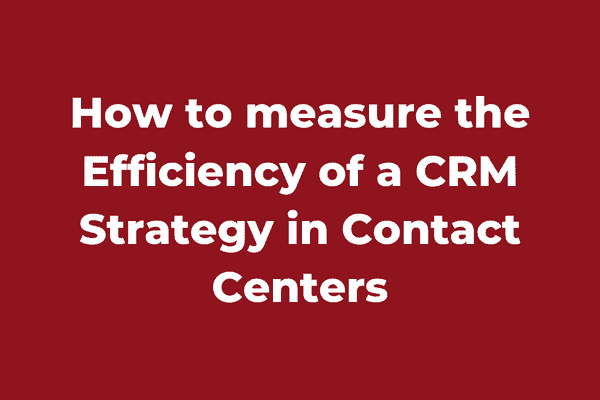Customer Relationship Management (CRM) is a strategy businesses use to manage interactions with existing and potential customers. CRM aims to improve customer satisfaction and loyalty and, ultimately, increase revenue. CRM strategies involve using technology to store and analyze customer data and automate and streamline sales and marketing processes.
In a contact center, facilitate managing the large volume of daily customer interactions by using essential CRM strategies. CRM software enables contact centers to easily store and access customer information such as purchase history and contact details. This information is a cornerstone to personalize interactions and improve the customer experience.
Measuring the efficiency of a CRM strategy in contact centers is essential because it allows us to determine whether the strategy is achieving its goals and to identify areas for improvement. Without measuring the efficiency of a CRM strategy, it isn’t easy to know whether the system is delivering a positive return on investment and if it is providing the desired outcomes.
Key points:
- Benefits of an effective CRM strategy concerning revenue, customer satisfaction and retention, and decision making
- The key metrics to track and analyze CRM strategy
- The steps to put in place a robust CRM measurement system to make the most of the CRM strategy
- Customer feedback and its role in improving the CRM strategy’s efficiency
The business benefits of an effective CRM strategy
Effective CRM strategies can bring a wide range of business benefits, including:
-
Increased revenue
By understanding customer needs and preferences, contact centers can create personalized marketing campaigns that are more likely to convert into sales. Additionally, by using CRM to analyze customer data, contact centers can identify new sales opportunities and cross-selling and upselling opportunities.
-
Improved customer satisfaction
Using CRM to personalize interactions and understand customer needs, contact centers can improve the customer experience and increase customer satisfaction. This can lead to increased customer loyalty and repeat business.
-
Increased efficiency
CRM software can automate and streamline sales and marketing processes, making it easier for contact centers to manage customer interactions. This can increase efficiency and productivity, allowing businesses to handle more customers with the same resources.
-
Improved decision-making
Contact centers use CRM software to store and analyze customer data in order to identify patterns and trends in customer behavior. This information is used to make data-driven decisions.
-
Better customer retention
By understanding customer needs and preferences, contact centers can create personalized retention strategies that will likely keep customers loyal. Additionally, by using CRM to analyze customer data, businesses can identify at-risk customers and take steps to prevent them from leaving.
-
Better communication
CRM software can help contact centers centralize customer data and communication, providing a consistent experience across all touchpoints. CRM can also provide insights into customer interactions and feedback, which can be used to improve communication and tailor messages to the customer.
Identifying Key Metrics for Measuring CRM Efficiency
The critical metrics for measuring CRM efficiency we are about to develop can be used to track and improve CRM efforts by providing contact centers with a clear understanding of how their CRM strategy is performing.
By regularly monitoring these metrics, contact centers can identify areas for improvement and adjust the CRM strategy as needed. This helps ensure that the strategy delivers the desired outcomes and provides a positive return on investment.
Several key metrics can be used to measure the efficiency of a CRM strategy in contact centers, such as:
First Call Resolution Rate (FCRR) :
Measure the efficiency of a contact center by using the First Call Resolution (FCR) rate as a metric. Calculate the FCR rate by taking the number of customer issues resolved during the first call, and dividing it by the total number of calls received.
A high FCR rate indicates that customers have their issues resolved quickly and effectively. In contrast, a low FCR rate may suggest that more calls are needed to resolve a customer’s issue or that customer service representatives are not adequately trained to handle specific problems.

Customer Satisfaction Scores (CSAT) :
Customer satisfaction scores are another metric used to measure the efficiency of a contact center. These scores are typically based on surveys given to customers after interacting with a contact center. The surveys usually include questions that assess the customer’s overall satisfaction with the service they received, as well as specific aspects of the service, such as the customer service representative’s knowledge and helpfulness. High scores indicate that the customers are satisfied with the service provided, while low scores may reveal areas where the contact center needs to improve.
It is also used as a metric for agent performance; managers can identify top and low performers and act accordingly by measuring how much customer satisfaction is correlated to a specific agent.
Net promoter score (NPS) :
NPS measures customer loyalty based on the question, “How likely are you to recommend our company/product/service to a friend or colleague?”
Customers respond on a scale of 0-10.
The score is calculated by subtracting the percentage of detractors (customers who respond with a score of 0-6) from the percentage of promoters (customers who respond with a score of 9-10).
A positive NPS indicates that more customers are likely to recommend the company, while a negative NPS suggests the opposite.
Customer Churn Rate:
Customer churn rate is a measure of customer retention for a contact center. It is calculated by taking the number of customers who discontinue using a product or service during a specific period, divided by the total number of customers at the beginning. A high churn rate indicates that many customers are leaving the service, while a low churn rate suggests that customers are retaining the service.
This metric is handy for businesses that rely heavily on recurring revenue, such as subscriptions, as it directly measures the effectiveness of customer retention efforts. It can also be used to evaluate the effectiveness of different retention strategies by comparing the churn rate.
Additionally, it is used to identify at-risk customers by analyzing the behavior of churned customers; managers can identify patterns that could determine which customers are at risk of canceling the service. This can help the company to offer promotions or provide personalized service to retain these customers.
Customer Lifetime Value (CLV):
Customer Lifetime Value (CLV) is a measure of customer retention for a contact center. It predicts the net profit attributed to a customer’s future relationship. It is calculated by taking the total revenue a customer is expected to generate over their lifetime minus the costs associated with acquiring and servicing that customer. A high CLV indicates that a customer is expected to create a large amount of revenue over their lifetime. Conversely, a low CLV suggests that a customer is not likely to generate much revenue.
This metric is handy for businesses that rely heavily on recurring revenue, as it directly measures the long-term value of a customer. It can also be used to identify and prioritize high-value customers; by comparing the CLV of different customers, managers can identify which customers are most valuable to the business and focus retention efforts on them.
Right-Party Contact (RCC)
Right-party contact can be used as a metric to assess the effectiveness of a CRM strategy. It records the percentage of calls that are answered by the intended or correct party, which is the person or department most suited to meet the needs of the consumer. It can reflect how well the contact center can reach the correct party on the first attempt, affecting customer satisfaction and the efficiency of the contact center’s operations.
Implementing a CRM Measurement System
A CRM measurement system for contact centers is a set of metrics and tools used to track and evaluate the performance of customer interactions and relationships. This can include metrics such as the ones we previously detailed. These metrics can be used to identify areas of improvement in the contact center, such as training needs for agents, and to help improve the customer experience.
The data collected by the CRM measurement system can also be used to identify trends and patterns in customer interactions, which can help to inform the development of new products, marketing campaigns, and sales strategies. This can help companies to make data-driven decisions to improve the customer experience and drive business growth.
The next chapter will explore the steps to set up a CRM measurement system for your contact center.
Seven steps to conceive a robust CRM measurement system for your contact center
The following is a set of steps to follow to implement a concrete CRM measurement system for your contact center:
1. Defining goals and objectives:
When defining goals and objectives for a CRM measurement system in a contact center, it is essential to consider the KPIs that align with them. It is also necessary to establish clear, measurable targets for each KPI to provide a benchmark for performance and track progress.
It is also primordial to gather and analyze data from various sources to comprehensively understand customer interactions and behaviors.
2. Setting up data collection:
When setting up data collection for a CRM measurement system in a contact center, it is important to identify the data sources, such as customer surveys, call center logs, sales data, and social media analytics.
Once identified, establish a process for regularly collecting and updating data from these sources. To ensure that the data is accurate and consistent, implement quality control measures such as validation checks and data cleansing. In addition, store the data in a secure location, such as a data warehouse or a cloud-based storage solution, and comply with regulations such as GDPR and HIPAA.
A data governance plan should be created to ensure that data is used and shared appropriately and that it aligns with the organization’s goals and objectives. Utilizing data integration tools and techniques, such as ETL (Extract, Transform, Load), can facilitate the collection and analysis of data from multiple sources.
Training staff on how to properly collect and input data to minimize errors and ensure consistency is crucial. In addition, the data collection process should be continuously reviewed to identify and address any issues and to ensure that it provides valuable insights for the organization.
3. Analyzing data:
 Analyzing data is crucial in creating a robust CRM measurement system for a contact center. To inform decision-making and drive improvements in customer service and operations, the process of data analysis involves using various techniques to extract insights from the collected data
Analyzing data is crucial in creating a robust CRM measurement system for a contact center. To inform decision-making and drive improvements in customer service and operations, the process of data analysis involves using various techniques to extract insights from the collected data
It is essential to identify which data is most relevant to the organization’s goals and objectives and focus on that data for analysis.
Utilizing appropriate data analysis techniques can help extract insights from the data. Enable decision-makers to identify improvement areas quickly by presenting these insights in an easy-to-understand format through visualizations, such as charts and graphs.
Identifying patterns and trends in the data can inform strategies for improving customer service and operations. Furthermore, using data to benchmark performance and track progress over time allows the organization to measure the effectiveness of its efforts to improve customer service.
We discuss the importance of data for contact centers and how to leverage data analytics to increase sales in our episode How to Increase Sales Performance in Outbound Contact Centers.
Finally, communicate the insights from data analysis to all stakeholders, including contact center staff and use them to inform and drive improvements in customer service and operations.
4. Communicating findings:
Communicating findings is essential in creating a robust CRM measurement system for a contact center. It involves sharing the insights from data analysis with all stakeholders, including contact center staff, and using them to inform and drive improvements in customer service and operations.
Present the findings in a clear, concise, and actionable format, such as a report or a dashboard. Create an effective communication plan that outlines the communication process. Tailoring the message to the audience, using language and visual aids that are easy to understand, highlighting the most important findings and recommendations for improvement, and providing context for how they align with the organization’s goals and objectives can help communicate the message more effectively.
To ensure that everyone knows the insights and can act on them, all relevant stakeholders, including contact center staff, management, and senior leadership, should be aware of the findings. Providing training and support to contact center staff can help them understand and apply the findings to their work. In addition, they encourage feedback and input from stakeholders to ensure that the results are relevant and actionable. Finally, they continuously review and update the communication process to ensure that it remains aligned with the organization’s goals and objectives and provides valuable insights.
Encourage a culture of transparency and open communication to help improve customer relationships.
5. Taking action:
Action is the final step in creating a robust CRM measurement system for a contact center. It involves using the insights gained from data analysis to inform and drive improvements in customer service and operations.
The first step is to identify areas for improvement based on the findings and develop a plan of action to address them. Prioritizing activities based on their potential impact and feasibility is also essential. Involving relevant stakeholders, including contact center staff, in the planning and implementing measures to ensure ownership is critical. Implementing the steps promptly and tracking progress is essential to ensure they have the desired effect.
It’s essential to monitor and adjust actions to ensure that they remain aligned with the organization’s goals and provide the desired results. Encouraging a culture of continuous improvement, always looking for ways to improve the customer service experience, leveraging technology and automation to enhance the efficiency and effectiveness of the actions taken, and using the insights and results of the steps to inform future data collection, analysis, and communication efforts create a continuous loop of improvement.
6. Regularly reviewing and refining:
Regularly reviewing and refining is essential to creating and maintaining a robust CRM measurement system for a contact center. Continuously monitor the system’s performance and adjust as needed to ensure that it remains aligned with the organization’s goals and objectives and provides valuable insights by involving in the process.
First, it’s important to set regular intervals for reviewing the system, such as monthly or quarterly. Assessing the system’s performance against established benchmarks and targets and identifying areas for improvement is crucial. It is also essential to examine the data collection, analysis, and communication processes to ensure that they are accurate, reliable, and consistent. It identifies and addresses any technical or operational issues impacting the system’s performance. Finally, seeking feedback from stakeholders, including contact center staff, to gain additional insights and identify areas for improvement can help improve the system.
Regularly evaluating the entire CRM measurement system and adjusting it to ensure that it remains relevant and practical over time is crucial to keep the system running efficiently.
7. Automating and integrating:
Automating and integrating are essential considerations when creating a robust CRM measurement system for a contact center. Automation can improve the efficiency and effectiveness of data collection, analysis, and communication processes. Integration can closely align the CRM measurement system with other systems and processes within the organization
A smart place to start is to use automation tools, such as data input software, to automate repetitive operations and eliminate errors. Implementing automation to improve data analysis and reporting speed and accuracy is also crucial. Ensuring that data is accessible is essential by investing in automation tools that integrate with other systems, such as other CRM systems, ERP systems, and marketing automation tools. Utilizing integration tools to connect the CRM measurement system with other systems, such as call center management software and customer relationship management software, to improve the accuracy and efficiency of data collection is also essential. Identifying and implementing opportunities for automation and integration that align with the organization’s goals and objectives is a must.
Leveraging AI and Machine learning to improve the automation and integration process, making it more efficient and accurate. Regularly evaluating the automation and integration of the CRM measurement system ensures it remains relevant and practical over time and keeps it running efficiently.
It’s important to note that implementing a CRM measurement system is an ongoing process. Therefore, regular review, refinement, and updating of the design are a must as business and customer requirements change.
By setting up a system for tracking CRM metrics, contact centers gain valuable insights into their CRM strategy’s performing. Which enables them to make data-driven decisions to improve their efforts. This allows for continuous improvement and optimization of the customer experience and the business’s overall performance. Bottom of Form
Specific tactics to improve CRM efficiency based on customer feedback
To improve CRM efficiency based on customer feedback, contact centers use tactics such as:
-
Acting on customer feedback:
By regularly collecting and analyzing customer feedback, businesses can identify areas for improvement in the customer experience. Then, by acting on this feedback, companies can take steps to improve the customer experience and increase satisfaction.
-
Personalizing interactions:
Businesses can personalize customer interactions by understanding customer needs and preferences by collecting and analyzing customer data. Using data to create targeted marketing campaigns, recommend products or services, and provide personalized customer service.
-
Empowering agents:
Agents with access to customer data and feedback are qualified to resolve issues quickly and effectively. Additionally, by providing agents with the necessary tools and resources, they can be more efficient in handling customer interactions.
-
Using chatbots and AI:
By using chatbots and AI to handle routine customer interactions, businesses can free up time to focus on urgent issues. Additionally, chatbots and AI can provide 24/7 availability to customers with personalization options to improve the customer experience.
-
Analyzing customer data:
Businesses can identify patterns and trends in customer behavior to improve the effectiveness of marketing and sales efforts.
-
Improving communication:
Businesses can provide a consistent experience across all touchpoints by centralizing customer data and communication. Additionally, by analyzing customer interactions and feedback, companies can improve communication and tailor messages to the customer.
Contact centers can improve CRM efficiency by implementing these tactics based on customer feedback. They can also ensure that their CRM strategy delivers the desired outcomes and provides a positive return on investment. This ultimately led to a better customer experience and increased revenue.
Conclusion:
In summary, Help build lasting relationships with customers and create effective interaction management Through the use of CRM strategies.
CRM strategies can bring a wide range of business benefits. Including increased revenue, improved customer satisfaction, efficiency, decision-making, better customer retention, and communication.
Implementing a CRM measurement system involves several steps, including identifying key metrics, analyzing data, and regularly reviewing and refining. By following best practices and using insights from CRM measurement, such as the one integrated into our OMNI+ solution, to optimize strategies, businesses can improve CRM efficiency and ensure that their CRM strategy delivers the desired outcomes and provides a positive return on investment.
Experience the ultimate customer engagement solution with NobelBiz Omni+. Our all-in-one contact center software offers advanced features such as omnichannel support, intelligent call routing, and real-time analytics. All backed by 24/7 customer support.
Boost your team’s productivity and improve customer satisfaction with NobelBiz OMNI+.

Andrei is an experienced marketing professional specializing in propelling growth for both B2B and B2C companies. Proficient in streamlining marketing operations and enhancing lead and customer experiences through SEO and marketing techniques.







